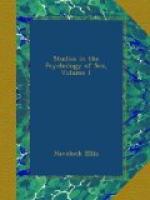during 1897-98 either in October or November,
and during 1896, constantly in October. Thus,
the periodicity of the rate of consumption of
prose-fiction corresponds with the periodicity
which is found to occur in the conception rate
and in sexual ecbolic manifestations.
It is necessary, however, to examine somewhat more closely the tables presented in these reports, and to compare the rate of the consumption of novels with that of other classes of literature. In the first place, if, instead of merely considering the consumption of novels per month, we make allowance for the varying length of the months, and consider the average daily consumption per month, the supremacy of March at once vanishes. February is really the month during which most novels were read during the first quarter of 1898, except at two libraries, where February and March are equal. The result is similar if we ascertain the daily averages for the first quarter in 1897, while, in 1896 (which, however, as I have already remarked, is a rather abnormal year), the daily average for March in many of the libraries falls below that for January, as well as for February. Again, when we turn to the other classes of books, we find that this predominance which February possesses, and to some extent shares with March and January, by no means exclusively applies to novels. It is not only shared by both music and poetry,—which would fit in well with the assumption of a sexual nisus,—but the department of “history, biography, voyages, and travels” shares it also with considerable regularity; so, also, does that of “arts, sciences, and natural history,” and it is quite well marked in “theology, moral philosophy, etc.,” and in “juvenile literature.” We even have to admit that the promptings of the sexual instinct bring an increased body of visitors to the reference library (where there are no novels), for here, also, both the spring and autumnal climaxes are quite distinct. Certainly this theory carries us a little too far.
The main factor in producing this very marked annual periodicity seems to me to be wholly unconnected with the sexual impulse. The winter half of the year (from the beginning of October to the end of March), when outdoor life has lost its attractions, and much time must be spent in the house, is naturally the season for reading. But during the two central months of winter, December and January, the attraction of reading meets with a powerful counter-attraction in the excitement produced by the approach of Christmas, and the increased activity of social life which accompanies and for several weeks follows Christmas. In this way the other four winter months—October and November at the autumnal end, and February and March at the spring end—must inevitably present the two chief reading climaxes of the year; and so the reports of lending libraries present us with figures which show a striking, but fallacious,




